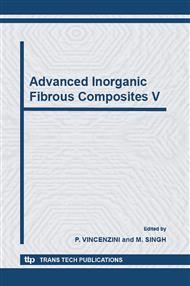p.107
p.115
p.124
p.130
p.141
p.147
p.153
p.163
p.174
Mechanical Behaviour Al-Matrix Composite Wires in Double Composite Structures
Abstract:
The fibre reinforced metal matrix composites (FRMMC-s) are one of the main groups of the composite materials. The composite wires are continuous-fibre-reinforced aluminium matrix composites, which are made by a continuous process. Composite wires already have a few experimental applications for the reinforcement of high voltage electric cables. Other experimental application fields of these materials are the preferential reinforcement of the cast parts. In this way significant decrease in the weight could be achieved. The aim of this study is to show the excellent mechanical properties of the composite wires, and the contact relationship between the mechanical and other properties (i.e. thermoelectric power) and the possibility of their standardized production. The continuous production process of the composite wires and their test results were are shown as well. The difference between the composite wire reinforced double composite structures and direct fibre reinforced blocks were delineated as well. In this paper specimens were examined by tensile tests, bending tests, thermal aging tests and thermoelectric power measurement.
Info:
Periodical:
Pages:
147-152
Citation:
Online since:
October 2006
Authors:
Price:
Сopyright:
© 2006 Trans Tech Publications Ltd. All Rights Reserved
Share:
Citation:


